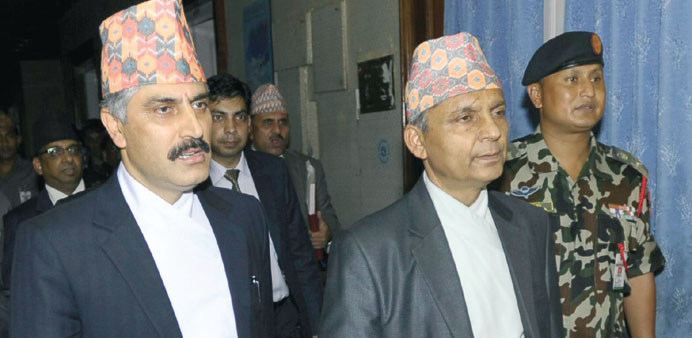Nepalese chairman of the Interim Council of Ministers, Khil Raj Regmi, right, accompanies Finance Minister Shankar Koirala as he carries a briefcase on his arrival to announce the new government’s budget for the fiscal year 2013-14 in Kathmandu yesterday.
IANS/Kathmandu
Nepal has released its economic survey at the end of fiscal year 2012-13 underlining that its economy has been marred by low economic growth, minimum progress in poverty reduction and high rate of currency depreciation.
Against the prediction of 5.5%, Nepal’s economic growth in the past fiscal year (2012-13) remained at 3.6%. For the past 10 years, the growth rate was recorded 3.7% in average. Both these figures achieved were far below the expectation, according to experts.
Nepal targeted to bring down poverty to 21 from 25.2%. However, poverty reduced marginally by 1.4 to settle at 23.8%.
Its currency depreciated by 8.2% against the target of keeping it below 7.5% mark. It impacted the exchange rate adversely as Nepalese rupee went up to as high as 97 for one US dollar. It was the highest exchange rate of Nepalese currency so far.
Nepal’s trade deficit also widened excessively. Its total trade deficit was recorded $4.57bn in the past one year as its imports rocketed by 21.2%.
Nepal’s only positively performing key sector was revenue collection. A total of $2.92bn revenue was collected across the country, but this achievement, too, was mainly due to the unsustainable customs duty levied on the imports into Nepal.
“The major challenge to our economy is to achieve a high level of economic growth. But there are many obstacles on its way,” said Shankar Koirala, minister of finance, while presenting the report on Saturday. “Poor performance of agriculture sector was the main reason for last year’s low growth rate,” said Rewat Karki, an economist with Nepal Rastra Bank, the central bank of Nepal.
The climate was unfavorable last year, while farmers did not get the fertilizers in time, Karki said, stressing that only by arranging proper irrigation and facilities to farmers in time could increase the growth rate next year. “But I’m not that much hopeful, as there are plenty of problems including uncertainties in government policy, minimum role of private sector and the lack of a full-fledged budget,” added Karki.

